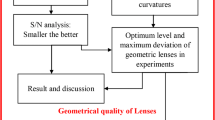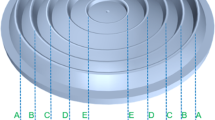Abstract
Most lenses on the market can be made by injection molding. However, defects such as weld lines and residual stress are often generated during the production of concave products. Compression molding eliminates these problems, and the cost of the required molding machinery is relatively low compared to other processes. The process can also be highly automated, which is essential for plastic manufacturing. This study proposes an innovative mold for compression molding for a double-concave lens. There is no requirement for angular alignment because the lens is axisymmetric. A compact compression mold without leader pins is created. Parameter optimization for the powder and granular PMMA is optimized using the Taguchi method. The significant compression molding parameters are the pre-pressing period, the pressing temperature, the pressing force, and the pressing period. The surface profiles of finished products are measured, and a factor response analysis is used to determine the effect of various parameters on the finished product. The pressing force was shown to be the most significant factor for powder. However, granules need a long enough pre-pressing time because the gap widens. A confirmation experiment was conducted with the optimized parameters. The profile of the compressed double-concave lens is measured and compared with the mold insert. Powder PMMA is more suitable for compression molding than granular PMMA. However, regardless of the material type, the compression-molded double-concave lens is 96% replicable or more.










Similar content being viewed by others
References
Xuehong L, Soo KL (2001) A statistical experimental study of the injection molding of optical lenses. J Mater Process Technol 113(1-3):189–195. https://doi.org/10.1016/S0924-0136(01)00606-9
Kuo-Ming T, Chung-Yu H, Wei-Chun L (2009) A study of the effects of process parameters for injection molding on surface quality of optical lenses. J Mater Process Technol 209(7):3469–3477. https://doi.org/10.1016/J.JMATPROTEC.2008.08.006
Xiaowei Z, Zhang Yun Y, Wenjie LM, Yuhong C, Huamin Z (2020) An imaging performance analysis method correlated with geometrical deviation for the injection molded high-precision aspheric negative plastic lens. J Manuf Process 58:1115–1125. https://doi.org/10.1016/J.JMAPRO.2020.09.017
Joseph BR, Rajendra BS, Jebaraj C (2016) Minimization of variation in volumetric shrinkage and deflection on injection molding of bi-aspheric lens using numerical simulation. J Mech Sci Technol 30(11):5143–5152. https://doi.org/10.1007/S12206-016-1032-6
Kuo-Ming T, Hao-Jhih L (2017) An inverse model for injection molding of optical lens using artificial neural network coupled with genetic algorithm. J Intell Manuf 28(2):473–487. https://doi.org/10.1007/S10845-014-0999-Z
Joseph BR, Rajendra M, Rajendra BS, Jebaraj C (2019) Injection molding process optimization of a bi-aspheric lens using hybrid artificial neural networks (ANNs) and particle swarm optimization (PSO). Measurement 134:359–374. https://doi.org/10.1016/J.MEASUREMENT.2018.10.066
Shih-Chih N, Po-Wen C, Ming-Shyan H (2020) Multilayer injection molding of high-profile convex lens. J Appl Polym Sci 137(17):48600. https://doi.org/10.1002/APP.48600
Davis B, Gramann P, Osswald T, Rios A (2003) Compression molding. Hanser, Munich
Saldivar-Guerra E (2013) Handbook of polymer synthesis, characterization, and processing. John Wiley & Sons Inc., Hoboken, NJ, USA, pp 451–461. https://doi.org/10.1002/9781118480793
Kalpakjian S, Schmid SR (2014) Manufacturing engineering and technology 7/E. Pearson
Benedikt S, Steffen W, Maik S, Nico V, Matthias W, Martin K, Karin W (2011) Characterization of micro-powders for the fabrication of compression molded THz lenses. J Infrared Milli Terahz Waves 32(7):943–951. https://doi.org/10.1007/S10762-011-9806-5
Fagan MD, Kim BH, Yao D (2009) A novel process for continuous thermal embossing of large-area nanopatterns onto polymer films. Adv Polym Technol 28(4):246–256
Zhang H, Li L, McCray DL, Yao D, Yi AY (2012) A microlens array on curved substrates by 3D micro projection and reflow process. Sens. Actuator A Phys 179:242–250
Heyderman L, Schift JC, David J, Gobrecht T, Schweizer LJ (2000) Flow behaviour of thin polymer films used for hot embossing lithography. Microelectron Eng 54(3-4):229–245. https://doi.org/10.1016/S0167-9317(00)00414-7
Abolfazl Z, Lin Z, Wenchen Z, Yi Allen Y (2021) Replication of plastic microlens arrays using electroforming and precision compression molding. Microelectron Eng 239-240:111529. https://doi.org/10.1016/J.MEE.2021.111529
Becker H, Heim U (2000) Hot embossing as a method for the fabrication of polymer high aspect ratio structures. Sens. Actuator A Phys 83(1-3):130. https://doi.org/10.1016/S0924-4247(00)00296-X
Lin CR, Chen RH, Huang C (2003) Preventing non-uniform shrinkage in open-die hot embossing of PMMA microstructures. J Mater Process Technol 140(1-3):173–178. https://doi.org/10.1016/S0924-0136(03)00709-X
Wu C-H, Lu C-H (2008) Fabrication of an LCD light guide plate using closed-die hot embossing. J. Micromech. Microeng. 18(3):035006. https://doi.org/10.1088/0960-1317/18/3/035006
Cheng-Hsien W, Chen-Hao H, Ya-Zhen H (2009) Parametric study of hot embossing on micro-holes. Adv Mat Res 74:251–254. https://doi.org/10.4028/www.scientific.net/AMR.74.251
Mirkhalaf M, Tor SB, Murukeshan VM, Loh NH, Lye SW (2010) Optimization of compression molding of stand-alone microlenses: simulation and experimental results. Polym Eng Sci 50(11):2216–2228. https://doi.org/10.1002/PEN.21738
Shamloo A, Fathi B, Elkoun S, Rodrigue D, Soldera A (2018) Impact of compression molding conditions on the thermal and mechanical properties of polyethylene. J Appl Polym Sci 135(15):46176. https://doi.org/10.1002/APP.46176
Taguchi G, Konishi S (1987) Taguchi methods orthogonal arrays and linear graphs: tools for quality engineering. American Supplier Institute, Dearborn, Michigan
Funding
This work was supported by the Ministry of Science and Technology of Taiwan (MOST 109-2221-E-992-003).
Author information
Authors and Affiliations
Contributions
Conceptualization: Cheng-Hsien Wu and Chun-Yu Liu. Methodology: Cheng-Hsien Wu and Chun-Yu Liu. Optimization: Chun-Yu Liu. Experiment: Chun-Yu Liu. Resources: Cheng-Hsien Wu. Writing: Cheng-Hsien Wu and Chun-Yu Liu.
Corresponding author
Ethics declarations
Competing interests
The authors declare no competing interests.
Additional information
Publisher’s note
Springer Nature remains neutral with regard to jurisdictional claims in published maps and institutional affiliations.
Rights and permissions
Springer Nature or its licensor (e.g. a society or other partner) holds exclusive rights to this article under a publishing agreement with the author(s) or other rightsholder(s); author self-archiving of the accepted manuscript version of this article is solely governed by the terms of such publishing agreement and applicable law.
About this article
Cite this article
Wu, CH., Liu, CY. Optimization of compression molding for double-concave lenses. Int J Adv Manuf Technol 125, 5089–5099 (2023). https://doi.org/10.1007/s00170-023-11052-6
Received:
Accepted:
Published:
Issue Date:
DOI: https://doi.org/10.1007/s00170-023-11052-6




